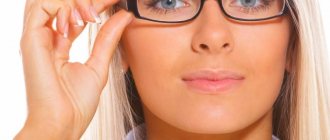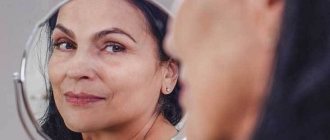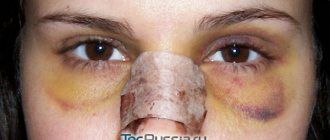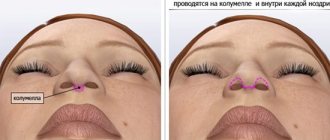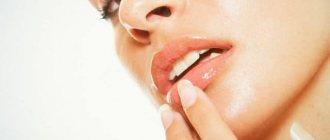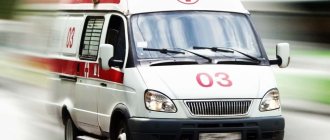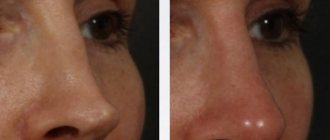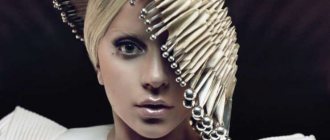- Complications of rhinoplasty
- Rhinoplasty and side effects
- Rehabilitation period and its stages
- Contraindications during rehabilitation
- Sports and alcohol after surgery
- Medicines during rehabilitation
- Massage and physiotherapy after rhinoplasty
- Reviews about rhinoplasty
Life after rhinoplasty worries many women who have not yet had the operation. Let's take a closer look at what complications rhinoplasty entails, how long swelling and bruising lasts, how to speed up the rehabilitation process and some other aspects of the procedure.
Features of the rehabilitation process after rhinoplasty
The nose is not only a part of the face, but also a very important organ with active blood circulation and a complex lymphatic system. And even the most skilled surgeon and a competently performed operation are not able to save the patient from risk. There is always at least a minimal probability of negative consequences occurring.
A feature of the recovery period after rhinoplasty is the need to strictly follow the doctor’s recommendations.
How long will you have to limit yourself? It all depends on the degree of intervention, age, skin condition and health of the patient.
The first month is especially important for successful rehabilitation. It requires close contact with the surgeon to adjust treatment regimens, prescribe new medications or physical therapy procedures. But even with such a targeted approach, it will take more than one week to regain vitality. The nose will take on its final shape only a year after the plastic surgery.
Recovery assistance
You can and should help your body get through the rehabilitation period after rhinoplasty faster and easier. To do this, just follow these simple recommendations:
- Follow a salt-free diet, supplementing your meals with vegetables and fruits, as well as proteins. It is advisable to minimize carbohydrates and fats.
- Use special gels - Traumeel S and Lyoton, after consulting a doctor. This will help get rid of bruises quickly.
- When preparing for bed, you should place pillows on your sides so as not to roll over while sleeping on your side or stomach.
Patience, calmness and confidence in the result are important qualities for obtaining a positive result. Reviews say that if the plastic surgeon is a professional and qualified specialist, then a beautiful and graceful nose will definitely please you. The main thing in this matter is that all actions are correct, not only during the operation, but also after.
Main stages of recovery
The entire rehabilitation process is usually divided into 4 main periods:
- The first week is the most difficult time, when the patient experiences difficulty with nasal breathing, suffers from pain and swelling, and poor health.
- The second stage (7-12 days) - the pain is still quite significant, any touch causes discomfort.
- The third stage (2-3 weeks) - bruises and hemorrhages begin to resolve, swelling subsides, the skin acquires sensitivity and a healthy color. Scars and cicatrices fade and become less noticeable.
- The fourth stage (4th week and after) - the pain goes away, the nose acquires the desired shape and proportions. It is at this stage that it is easy to detect indications for a repeat procedure.
Sick leave for the day of surgery and the recovery period is usually not issued. But if rhinoplasty was difficult and resulted in many complications, it is possible to provide a certificate of incapacity for work for no more than 10 days.
First days
If rhinoplasty was performed under local anesthesia, the patient is allowed to leave the hospital on the same day, after the anesthesia wears off. The use of full anesthesia will require you to remain under medical supervision until the next morning. There is no need to stay in the clinic any longer.
When sending a patient to complete his treatment at home, the surgeon gives the following recommendations:
- maintain bed rest, move less and not strain;
- do not remove or try to look under the splint;
- After the operation, you should not laugh, sneeze, blow your nose, tilt your head, or make sudden movements.
Nasal turundas placed by the surgeon must be changed as they swell, as well as monitor the condition of the plaster cast, regularly check the temperature and record general well-being.
In the first days after rhinoplasty, it is very important not to catch a cold. A runny nose and cough will create severe discomfort and can completely cancel out all the work of the plastic surgeon. If your nose begins to bleed and other alarming symptoms appear, contact your ENT doctor or the specialist who performed the operation.
Total duration of rehabilitation period
The duration of recovery after the procedure is primarily influenced by the type of intervention. For greater clarity, we will combine all the dates for returning to normal life in a table.
| Nature of the operation | Duration of rehabilitation |
| Open plastic | A year or more |
| Closed plastic | 6–7 months |
| Correction of nostrils and nose wings | 2.5–3 months |
| Improving the shape of the tip of the nose | 7–8 months |
| Rhinoplasty using an endoscope | 2–3 months |
| Repeated operation | 1–1.5 years |
| Nose reconstruction | Year |
The best time for the procedure is from 25 to 45 years. In older patients, tissue regeneration slows down and rehabilitation is noticeably prolonged. For people over 55–55 years of age, rhinoplasty may be contraindicated due to various systemic and chronic pathologies.
The thickness of the skin also affects the healing time. With oily, acne-prone dermis, the scars disappear slowly, and the swelling takes a long time and is difficult to subside.
How to get rid of swelling and hematomas as quickly as possible
Swelling and bruising after rhinoplasty is quite common. All patients, without exception, encounter them, so there is no need to worry about this.
A special compression bandage will help prevent the appearance of unpleasant symptoms, which compresses the lymphatic vessels and thereby maintains the shape of the nose and does not allow it to swell. After removing the splint for 14–20 days, it is recommended to cover the bridge of the nose with a bandage at night, thereby preventing morning swelling. Such simple measures will speed up tissue healing without the use of expensive products.
Pay attention to the time of the operation - the procedure on menstruation days is always accompanied by heavy bleeding and the appearance of large dark blue hematomas. Carrying out two procedures simultaneously—rhinoplasty and blepharoplasty—can cause severe swelling under the eyes.
How long do swelling and bruising last? It all depends on the individual characteristics of the body. For some, the main symptoms disappear after a week, for others they persist for a year. Physiotherapy and massage will help you quickly cope with the problem.
Physiotherapy will speed up healing
To alleviate the patient’s condition, improve blood circulation and lymph flow in the tissues of the nose, the following physiotherapy procedures are widely used:
- electrophoresis;
- microcurrents;
- phonophoresis;
- Darsonval.
Starting from the second week, all patients, without exception, are prescribed ultrasound. High-frequency waves strengthen the walls of capillaries, accelerate the resorption of scars and seals, prevent postoperative bleeding and reduce swelling.
Massage and self-massage
For swelling of the periosteum and soft tissues, massage is indicated - manual or hardware lymphatic drainage.
You should massage your nose yourself very carefully, gently squeezing the tip with two fingers and moving to the bridge of the nose for 30 seconds. Such movements can be performed up to 15 times a day.
Medicines during rehabilitation
Medicines can also ease the recovery period. The following medications are most often used after rhinoplasty:
- diuretics - Furosemide, Hypothiazide, Veroshpiron, Torasemide, herbal teas containing lingonberry leaves will help with severe swelling that reaches the cheeks;
- Lyoton and Troxevasin ointments will help prevent morning swelling;
- if the temperature rises, take an antipyretic - Paracetamol, Voltaren, Ibuklin;
- hematomas will be relieved by means that improve blood circulation - Bruise off, Traumeel, Dolobene;
- Contractubex will help soften scars and remove them;
- for nasal congestion, use nasal drops - Xylometazoline, Otrivin, Nazivin;
- If allergies occur, take Diazolin, Suprastin, Cetrin, Telfast.
For the first 2 weeks after surgery, it is recommended to use vitamin-mineral complexes and immunostimulants: tincture of ginseng, eleutherococcus or echinacea. To prevent herpes, use Fenistil Pencivir and Acyclovir gel.
If tablets and ointments do not help with swelling, the surgeon prescribes Diprospan. The injection is given both in the muscle and in the soft tissue of the nose.
Antibiotics - Ampicillin, Gentamicin, Amoxicillin - will help to avoid secondary infection. Antibacterial treatment should be accompanied by probiotics. They will protect the gastrointestinal tract from the harmful effects of antimicrobial therapy. In addition, treat tissues twice a day with an antiseptic.
For external use, you can use Dimexide. The drug has established itself as an excellent anti-inflammatory and analgesic agent. To make a lotion, use a 25% solution - dip a gauze cloth into it, squeeze it out and apply it to the nose for 30 minutes.
Injection in the nose
Sometimes additional manipulations are required to relieve swelling - injections into the nose of drugs that have an anti-inflammatory and healing effect, they are done with a very thin needle, so they are completely painless.
The most commonly used drugs are:
- based on hyaluronidase - this enzyme breaks down hyaluronic acid, thereby “freeing” tissues from fluid. In case of edema, this process is stimulated with an injection. In addition, the substance has an anti-inflammatory effect and promotes the production of collagen fibers;
- based on glucocorticoids - the introduction of a substance increases the level of steroid hormones, which are produced during stress, injury and blood loss. The essence of its action is to increase blood volume and circulation intensity. Glucocorticoids stimulate protein and carbohydrate metabolism, promoting rapid healing;
- diprospan - provides an almost instant effect.
- Betamethasone disodium phosphate effectively relieves swelling, stops the formation of scars and has a good effect on hematopoiesis. It should be used with caution, as the drug increases blood pressure and provokes agitation and insomnia.
The drugs are prescribed by a doctor, preferably the one who performed the operation. The duration of the course and the amount of medication is calculated for each case. If the injections have been used for a long time, they cannot be canceled abruptly: first the volume is reduced, then given every other day and, finally, canceled.
What not to do after surgery
When planning to undergo rhinoplasty, you should prepare for many restrictions that you will have to comply with during rehabilitation. Some of them need to be performed only in the first days, others - over several months.
Prohibitions in the early period
As a rule, the early postoperative stage includes restrictions imposed on the patient until discharge from the hospital. But we will extend it and look at what not to do in the first week:
- paint;
- expose yourself to any physical activity;
- grimace;
- fly on airplanes;
- wash your hair and face.
If you need to do your hair, use the option of throwing your head back, like in a hairdresser.
At first, it is recommended to sleep only on your back, with a high pillow under your head. It is also advisable to avoid stress, not drink alcohol, and avoid spicy, too hot or cold foods.
When caring for your nose, don't forget about your face. Cleanse your skin with a cotton swab soaked in hypoallergenic toner or micellar water. Avoid any creams or cleansing procedures.
Late deadline restrictions
A week passed, the doctor removed the cast and you breathed freely. But it’s too early to rejoice. There are still many restrictions that need to be followed for some time:
- During the rehabilitation period, sports are absolutely contraindicated, only walking at an easy pace. But even when returning to training, avoid exercises that cause a rush of blood to the head;
- for 1–1.5 months, try not to blow your nose;
- for the same period, exclude swimming in the pool and any other body of water from your life;
- you cannot sunbathe, go to the bathhouse or sauna, take a contrast shower, or wash for a long time in hot water;
- beer, champagne, low-alcohol drinks are banned for six months. This restriction does not apply to red wine - it is permissible to drink it 30 days after plastic surgery.
Avoid any cosmetic procedures for at least 3 months. You will also have to wait a bit with sex.
How to properly clean your nose after rhinoplasty
If crusts form on the mucous membrane and ichor accumulates, the nose can be gently cleaned with a cotton swab moistened with peach oil or Vitaon balm.
Another quick way to get rid of discharge and crusts is to rinse with pharmaceutical products or a solution of sea salt. You can irrigate the mucous membrane at least every hour, the main thing is not to dry it out.
Pregnancy after rhinoplasty
Why can't you get pregnant after surgery? The fact is that during the period of bearing a child, serious hormonal changes occur in a woman’s body, which may not have the best effect on scarring and tissue healing. Therefore, postpone pregnancy for at least 6 months, and preferably a year.
Physiotherapy
During the rehabilitation period, many restrictions must be observed. They fully apply to a variety of cosmetic procedures. However, there are also special ones aimed at speedy tissue restoration and relieving undesirable consequences - swelling, hematomas, calluses.
Massage after rhinoplasty
In its usual form, massage is prohibited: active displacement of soft tissues will ultimately lead to displacement of bone tissues, held only by surgical sutures. However, there is one specific complication after surgery, which requires massage to remove.
Quite often, after correction, a hump appears on the back of the nose. This is a cartilaginous seal that can be removed by massage. As a rule, the course is only 3 sessions.
On your own, after the strips are removed, you can perform the following procedure:
- pinching the tip of the nose with two fingers, gentle pressure – 30 seconds;
- pinching the nose closer to the bridge of the nose – 30 seconds.
Such techniques are carried out up to 15 times a day. They allow you to somewhat reduce swelling and restore normal blood circulation.
The massage after surgery is reviewed in this video:
Microcurrents
Exposure to weak electrical impulses is used to restore tissue sensitivity and improve blood circulation. The procedure performs the same role after rhinoplasty. Due to tissue displacement during correction, the functioning of nerve endings is disrupted. As a result, patients often complain of numbness and numbness in this area. Microcurrents restore normal innervation.
As a rule, galvanization is prescribed 10–14 days after surgery, when the plaster splints are removed. Among other things, microcurrents improve peripheral blood circulation, and, therefore, help relieve swelling. Sessions are repeated every 2 days, the course includes from 5 to 10 procedures.
Phonophoresis
The procedure combines the effects of ultrasonic waves and medications. In this way, a more effective effect of medications is achieved. The fact is that for the most part, the active substances required to restore the skin cannot penetrate the horny barrier. Exposure to ultrasound expands the sweat and sebaceous ducts, through which the medicine enters the depths of the dermis.
Phonophoresis takes no more than 15–10 minutes. A medicinal product in the form of a gel is applied to the skin, and then the area is treated with an ultrasound probe. The procedure is completely painless and is prescribed to quickly relieve swelling and bruises. In addition, it allows you to supply the skin with vitamin and protein complexes.
Darsonval
Exposure of the skin to high frequency currents.
In this case, small muscles contract, so that the patient experiences a characteristic tingling and tingling sensation during the session. Darsonval stimulates blood circulation and improves tissue innervation, while sensitivity is quickly restored and swelling goes away. Darsonval is prescribed 7–10 days after removal of plaster splints. If you are highly sensitive to electric current, it is better to replace the procedure with microcurrents, in which muscle contraction does not occur.
The video below will tell you about the desired procedures after rhinoplasty:
Other
Other methods are also used during rehabilitation.
- “By default,” ultrasound is prescribed after rhinoplasty, regardless of how severe the swelling is and how cartilaginous growth appears. Exposure to ultrasound stimulates the walls of the capillaries, which leads to improved blood flow and, therefore, eliminates swelling. The first session is carried out 10 days after rhinoplasty. The course consists of 8 procedures, the effect is repeated at least once every 3 days.
- Laser processing is a more modern and expensive method. Exposure to laser radiation stimulates the work of the skin cells themselves, which accelerates the regeneration of soft tissue restoration. In addition, laser treatment prevents the appearance of scars. The first session is scheduled for 10–14 days, the course includes 10 procedures, they are carried out every day.
In any case, the procedure is prescribed by the doctor after examination and consultations - if necessary, with other specialists. It is prohibited to independently decide which methods are suitable and which are not.
Possible complications
All unpleasant consequences of rhinoplasty are divided into 2 groups - aesthetic and functional. The first include unplanned deformation of proportions, drooping of the tip of the nose, and asymmetry. Functional deficiencies are those that cause difficulty breathing.
Complications can develop at any time - both immediately after rhinoplasty and a month later.
Early consequences include:
- severe swelling. If they are unevenly distributed, temporary facial asymmetry may be observed;
- numbness of the nose, tongue and upper lip. It occurs as a result of general anesthesia.
A more serious danger is posed by complications, which in the normal course of the recovery period should not exist in principle:
- damage to bone and cartilage tissue;
- infection of the surgical site;
- necrosis of skin and bone;
- seam divergence;
All these problems can be caused not only by the surgeon’s error, but also by the individual characteristics of the patient’s body. Any of these complications requires urgent medical attention.
Long-term consequences
Very often, negative consequences arise after the end of rehabilitation. In this case, we are most often talking about distortion of odors or complete disappearance of the sense of smell, the unexpected appearance of allergies, narrowing of the nasal canal and breathing problems.
In the long term, other unexpected complications may appear:
- swelling of the tip of the nose;
- the formation of adhesions and rough scars, the removal of which requires separate intervention;
- acute or chronic rhinitis;
- depression (dent) on the back of the nose;
- callus;
- deviated septum;
- hard bumps on the periosteum;
- facial nerve damage.
All these complications can result from poor nasal care during the rehabilitation period.
Contrary to popular belief, the number and severity of the consequences do not depend in any way on the time of the manipulation - the operation can be done in summer and winter. The main thing is that you have time for rehabilitation.
Revision rhinoplasty
Unsuccessful rhinoplasty often becomes the reason for returning to the doctor. However, the secondary procedure may be much more difficult and more expensive than the first. It often ends in complications and requires long-term rehabilitation. Sutures are removed only on days 7–8, and swelling and hematomas do not disappear for 2 months.
Repeated rhinoplasty is performed no earlier than a year after the primary, when the body is sufficiently strong and the nose takes its final shape.
Expert recommendations
How to reduce the likelihood of unpleasant consequences? Experts advise paying special attention to your diet and excluding all types of berries, citrus fruits, tomatoes, vinegar, watermelon, grapes, garlic, apricots, peaches, fish oil and cranberry juice from your diet for 2 weeks.
Also, during the rehabilitation period, it is advisable to abandon blood thinners and weight loss medications. Do not use nicotine patches or chewing gum.
Also read: 11 tips from a surgeon for a quick recovery after surgery.
Medicines during rehabilitation
By following the recommendations, rehabilitation will be successful.
Medicines during the rehabilitation period should be prescribed only by a doctor, based on your specific case, allergies and similar factors. Antibiotics, anti-inflammatory drugs, and painkillers are mandatory. The former are taken according to the course, 1-2 times a day during the recovery period, and the latter are taken depending on pain during 4-10 days of rehabilitation.
Injections after rhinoplasty are prescribed to eliminate swelling during rehabilitation. The drug itself is called Diprospan, but its injections are very unpleasant. All patients report acute pain during the procedure. You can use the patch after rhinoplasty for the same purpose. However, after removing it, an influx of edema may occur.
Reviews from patients and cosmetologists about rehabilitation after rhinoplasty
Irina, 25 years old, Yaroslavl:
Since childhood I suffered from snub nose, so I decided to get a new nose. It was very scary, but since I had already gotten ready... I took a vacation from work. Everything went well. There were no complications other than swelling and bruising. At first I couldn’t breathe at all, Nazivin was dripping. Then the condition returned to normal. The nose became smooth and straight, much more beautiful than it was before.
Valeria, 28 years old, Tomsk:
I went for rhinoplasty to narrow the round tip of my nose. The rehabilitation went somehow unnoticed, the splint fell off on its own, and I didn’t take any painkillers. The only BUT is that the skin on my nose after the operation became terribly oily. Whatever I didn’t use. Tonics, lotions, mattifying powder - all to no avail. I read about grape seed oil and it really helped. Sebum secretion has returned to normal.
Georgy, plastic surgeon, 22 years of professional experience:
Strict adherence to the doctor’s recommendations during the rehabilitation period is one of the main components of a successful operation. There are few rules and there is nothing complicated about them, but ignoring them can nullify the efforts of even the best surgeon. I advise you to pay attention to the cost of rhinoplasty - you cannot save when it comes to beauty and health. Choose the best clinic and everything will be fine.
Rhinoplasty and side effects
It is necessary to immediately make a reservation that there are side effects that always or are more likely to appear after rhinoplasty surgery. They take place in the first weeks of the rehabilitation period:
- Bruises in the eye area, most often burgundy in color.
- Nausea.
- Severe nasal congestion.
- Difficulty breathing due to tampons.
- Numbness of the nose or its tip.
- Weakness and increased fatigue.
- Temperature increase.
- Nosebleeds that need to be blocked with a tampon.
Answers on questions
How long does it take for the nose to heal, when the plaster is removed and the swelling goes away?
The splint or splint is removed after 7–12 days of rehabilitation. Then, if necessary, the external sutures are removed. The main swelling disappears after 2 weeks, but residual swelling may persist for up to 12 months. Complete healing occurs no earlier than a year later.
What to do if a hump appears on the bridge of the nose after rhinoplasty?
This is a fairly rare complication of an aesthetic nature. Most often it occurs due to the fault of medical personnel and requires additional surgical correction. If a cartilaginous compaction has formed more than a year after the initial plastic surgery, you will most likely undergo a full-fledged operation under general anesthesia.
There was a smell of subcutaneous fat after rhinoplasty. Is it dangerous?
No need to worry about this. The feeling of foreign odors is a completely normal phenomenon, but for your own peace of mind, you should consult an ENT doctor.
Much more dangerous is the feeling of a putrid odor, noticeable even to others and accompanied by foul-smelling discharge. All this indicates the addition of a bacterial infection.
Is it possible to sleep on your side and smoke after surgery?
No, you can't do this. With a lateral position, pressure on one side of the nose increases significantly, which can lead to curvature of the wall.
Smoking is no less dangerous. Nicotine causes a sharp spasm of blood vessels and disrupts blood circulation, which slows down tissue healing. Avoid this bad habit for at least a month.
How painful is it to remove stitches?
Removing sutures is very simple - the stretched threads are first cut with medical scissors and then carefully pulled out of the skin. The feeling is unpleasant, but quite tolerable.
How long after rhinoplasty can I play sports?
You will be able to return to training no earlier than 2–3 months after surgery. It all depends on how you feel and the speed of healing of the soft tissues. Put off hand-to-hand combat, boxing and other types of martial arts for at least six months.
When can I wear glasses again?
In order not to injure the bridge of the nose and not to disturb the acquired shape, delay wearing glasses for 3 months. For myopia and farsightedness, use corrective lenses.
General tips for post-operative rehabilitation
Nose correction
There are a lot of plastic surgeries performed. One of the popular areas of facial correction is the nose. The success of the procedure depends not only on the hands of the plastic surgeon, but also on the patient’s compliance with the rules during the recovery period. Rehabilitation also implies adherence to the necessary prohibitions. Alcohol after rhinoplasty is an absolute contraindication.
Rhinoplasty, despite its popularity, is a rather serious surgical procedure. The recovery period is slow and until the final result, your nose and well-being will change several times.
After anesthesia
As soon as the patient wakes up after anesthesia, his first sensations are weakness, drowsiness, and nausea.
Such side effects appear after anesthetics. Once they are eliminated from the body, the symptoms will go away. After the operation is completed, turundas are inserted into the patient’s nose, and a plaster or plastic bandage is applied to the sniffing organ itself. Therefore, it will not be possible to see what this area looks like immediately after surgery.
Important! It is strictly forbidden to remove the plaster cast and cotton pads on your own.
It is not even recommended to use clothes that you have to put on over your head, especially with a narrow collar.
Appearance after surgery
But, if you look at the face, it is already noticeable that the intervention was serious. The eyelids and nose area all look swollen with bruises. Even the cheeks can be affected. After a week, the fluid will decrease and the patient will look like himself.
Rehabilitation by day
It is divided into several stages and contains the following points.
First two days
- The patient experiences pain, so he is forced to take painkillers as prescribed by the doctor.
- A course of antibiotics is required to eliminate the risk of infection.
- For the first few days, a person is forced to walk with hemostatic turundas that absorb secretions.
- The patient is forced to breathe through his mouth until the turundas are removed.
- When the old turundas are removed, the mucous membrane is treated with special means for speedy rehabilitation, then new ones are inserted. Contrary to misconceptions, the procedure for removing turundas is completely painless.
First 7 days
The patient is recommended to lie more on his back.
In 2 weeks
The sutures are removed, and the cast or fixing bandage is removed. The itching and irritation caused by the plaster goes away. The main thing is to endure this period and not remove the bandage yourself, so as not to deform the still unhealed nose and spoil the result of rhinoplasty. If everything went well, then on day 10 the plaster itself may fall off. In this case, you should definitely contact a surgeon.
When the tampons are removed, there are still stitches in the nostrils and in the folds of the wings of the nose. You cannot pull them with tweezers, otherwise the seams may come apart and remain as unsightly scars. During this period, it is not recommended to actively show facial expressions and laugh; lip movements can also affect the course of recovery. In the first two weeks the voice is nasal, but this goes away over time.
The duration and severity of recovery depends on the extent of surgical intervention. The wider the area of damage, the greater the discomfort. If the correction was carried out on the tip of the nose, then rehabilitation will take place quickly, within a week, with minimal swelling, unlike plastic surgery of the bridge of the nose.
After a 2 week break after rhinoplasty
The next stage of recovery lasts 2 weeks after surgery and 2.5 months. It is not as difficult as the postoperative period. The stitches have already been removed and the splint is missing. Discomfort occurs when breathing, which cannot yet be fully nasal due to long-term swelling. The bruises have not yet gone away, but the outlines of the nose are already visible. Although, it will still be approximately 2 times larger than planned due to swelling, which can remain in the nose area for up to 6 months. The final version of the nose is far from complete, because in 3 months only 50% of the swelling will go away. Therefore, you will have to wait about 1 year.
At the end of the first month after rhinoplasty, you can go out in public and not hide, fearing for the appearance of your face. The size of the nose will change over several months, improving in shape.
Final period
Starting from the third postoperative month, final rehabilitation begins. During this period, the swelling goes away completely, the nose becomes normal in shape and size. With a successful operation, the imperfections that cause discomfort should go away. If the surgeon made a mistake, the effect will be the opposite. At this stage, you can summarize the operation and determine whether it was successful or not.
